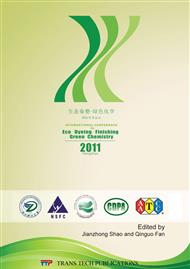p.589
p.593
p.598
p.603
p.608
p.613
p.619
p.625
p.631
Effect of Chemical Finishing on Water Retention of Knitted Pure Cotton Fabrics
Abstract:
The effect of chemical finishings on water retention of knitted pure cotton fabrics has been studied in this paper. Knitted cotton fabrics are not readily dried after home laundering, leading to high consumption of energy for drying. With the increasing environmental concerns, it is important to reduce the water retention of the knitted pure cotton fabrics. In this study, the effect of hydrophilic finishing, hydrophobic finishing and resin finishing on water retention of fabrics was systemically investigated. The results showed that the hydrophilic finishing agent and hydrophilic softener have little influence on water retention of the fabrics, while the resin significantly decreases the water retention. The hydrophobic finishing agent and hydrophobic softener reduce the water retention. However, it was also found that the water retention has positive relationship with the interaction of hydrophobic finishing agent and resin. In addition, a mathematical equation between water retention and the amount of hydrophobic finishing agent and resin was established.
Info:
Periodical:
Pages:
608-612
Citation:
Online since:
January 2012
Authors:
Price:
Сopyright:
© 2012 Trans Tech Publications Ltd. All Rights Reserved
Share:
Citation:


